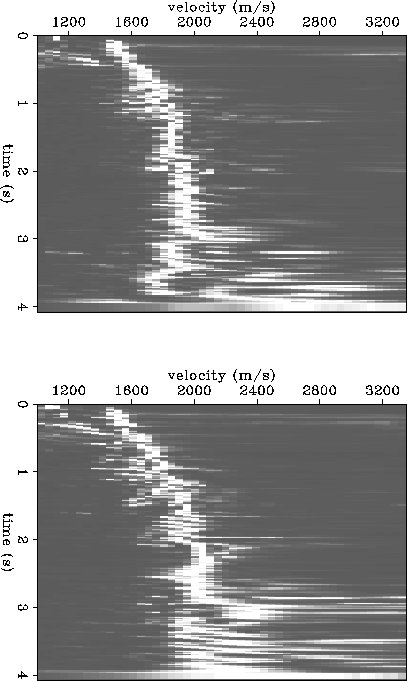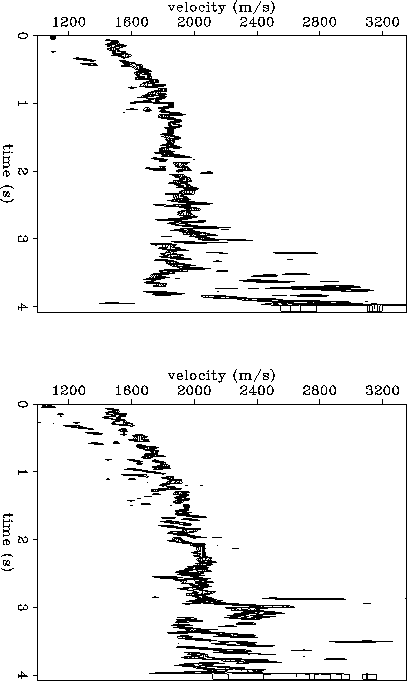




Next: A brief interpretation
Up: MARINE DATA EXAMPLE
Previous: Stacking velocity analysis
Figure ![[*]](http://sepwww.stanford.edu/latex2html/cross_ref_motif.gif) shows two migration velocity semblance panels. The top
panel corresponds to the surface location at x = 4 km, and the bottom
panel to x = 4.7 km. Figure
shows two migration velocity semblance panels. The top
panel corresponds to the surface location at x = 4 km, and the bottom
panel to x = 4.7 km. Figure ![[*]](http://sepwww.stanford.edu/latex2html/cross_ref_motif.gif) contains the same information,
but is plotted in contours as opposed to raster. At this point,
I have not spent any extra effort
trying to fine-tune the migration velocity algorithm. Already, however,
the migration velocity spectrum looks better resolved than the stacking
velocity spectrum, especially when comparing the contour plots of
Figure
contains the same information,
but is plotted in contours as opposed to raster. At this point,
I have not spent any extra effort
trying to fine-tune the migration velocity algorithm. Already, however,
the migration velocity spectrum looks better resolved than the stacking
velocity spectrum, especially when comparing the contour plots of
Figure ![[*]](http://sepwww.stanford.edu/latex2html/cross_ref_motif.gif) to Figure
to Figure ![[*]](http://sepwww.stanford.edu/latex2html/cross_ref_motif.gif) . Still, there is considerable
migration semblance smear, and I need to fine-tune the algorithm.
. Still, there is considerable
migration semblance smear, and I need to fine-tune the algorithm.
Currently, the main computational core of the CM code is running at
about 420 Mflop/s on 8k processors. A prestack migration velocity
analysis of 32 48-fold CMP gathers, 2,000 samples per trace,
with 48 stacking velocities and 256 output time samples, requires
a total of about 255 cpu seconds on 4k processors.
About 30 s of that time is required
to read input data from an NFS mounted disk to the front-end memory,
another 10 s to transfer the data from the front-end to the CM, about
210 s to do the computations within the CM, and about 5 seconds to
write the results from the CM to front-end to disk. As opposed
to the stacking velocity analysis algorithm, the migration velocity
analysis is mostly cpu bound, since I/O requires only about 18% of the total
run time. Addition of a data vault or fast disk array will only speed
the migration velocity analysis by a factor of about 1.2x.
ktvelR
Figure 7 Migration velocity panels, raster
display. The top panel corresponds to a surface location at 4.0 km, and
the bottom panel corresponds to a surface location at 4.7 km.
 ktvelC
ktvelC
Figure 8 Migration velocity panels, contour
display. The top panel corresponds to a surface location at 4.0 km, and
the bottom panel corresponds to a surface location at 4.7 km.






Next: A brief interpretation
Up: MARINE DATA EXAMPLE
Previous: Stacking velocity analysis
Stanford Exploration Project
11/18/1997
![[*]](http://sepwww.stanford.edu/latex2html/cross_ref_motif.gif) shows two migration velocity semblance panels. The top
panel corresponds to the surface location at x = 4 km, and the bottom
panel to x = 4.7 km. Figure
shows two migration velocity semblance panels. The top
panel corresponds to the surface location at x = 4 km, and the bottom
panel to x = 4.7 km. Figure ![[*]](http://sepwww.stanford.edu/latex2html/cross_ref_motif.gif) contains the same information,
but is plotted in contours as opposed to raster. At this point,
I have not spent any extra effort
trying to fine-tune the migration velocity algorithm. Already, however,
the migration velocity spectrum looks better resolved than the stacking
velocity spectrum, especially when comparing the contour plots of
Figure
contains the same information,
but is plotted in contours as opposed to raster. At this point,
I have not spent any extra effort
trying to fine-tune the migration velocity algorithm. Already, however,
the migration velocity spectrum looks better resolved than the stacking
velocity spectrum, especially when comparing the contour plots of
Figure ![[*]](http://sepwww.stanford.edu/latex2html/cross_ref_motif.gif) to Figure
to Figure ![[*]](http://sepwww.stanford.edu/latex2html/cross_ref_motif.gif) . Still, there is considerable
migration semblance smear, and I need to fine-tune the algorithm.
. Still, there is considerable
migration semblance smear, and I need to fine-tune the algorithm.

